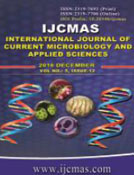


 National Academy of Agricultural Sciences (NAAS)
National Academy of Agricultural Sciences (NAAS)

|
PRINT ISSN : 2319-7692
Online ISSN : 2319-7706 Issues : 12 per year Publisher : Excellent Publishers Email : editorijcmas@gmail.com / submit@ijcmas.com Editor-in-chief: Dr.M.Prakash Index Copernicus ICV 2018: 95.39 NAAS RATING 2020: 5.38 |
Onychomycosis is probably the most common of all nail disorders, accounting for approximately 50% of all nail problems. Due to the increasing incidence of onychomycosis, it was thought worthwhile to undertake a clinicomycological study on this problem. 100 Patients seeking medical advice at the Dermatology outpatient department for nail abnormalities and who had clinical features suggestive of onychomycosis were included in the study for a period of one year. Scrapings were collected from the advancing infected edge as close to the cuticle as possible and from the underside of nail plate with a sterile scalpel blade, and direct microscopy using 10% KOH and culture on SDA was done. The tubes were incubated at room temperature for four weeks. Dermatophytes and non dermatophytes were identified by gross colony morphology, microscopic examination with Lactophenol cotton blue (LCB) preparation and by gram staining and Candida albicans was confirmed by germ tube test. Direct microscopy was positive in 57 patients while 43 patients did not yield a positive result. Culture positivity was noted in 51 patients. Trichophyton species was the most common pathogen isolated in cultures (45.09%). Among these 12 patients yielded T.rubrum, 9 yielded T.mentagrophytes and 19 yielded Candida albicans. Direct microscopy using KOH is a simple and relatively quick method to detect the presence of fungus. Culture helps to identify the species of the fungus.
 |
 |
 |
 |
 |